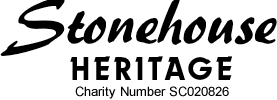An old word for Holy in German ‘Heiligt’, also means Healthy and on this little Crusade, there is an ascent, but no visible hills So, slow the pace, take a thankful breath of ice-cream moorland sir, and murmer “This is my own, my native land’’. “A refreshing tonic erects the body, clears the vision to observe, (in this, one of the oldest Parishes in Scotland, where the W. and S.W. storms abate in violence before reaching Stonehouse,) our Ancestors’ dwellings here. Precious, shapely little historic stones they are, left to us by the seas of time, yet in verdant, green surroundings “This fertile region, green with wood”.
Yes! As Stonehouse, halfway between Edinburgh and Ayr, was at one time referred to “Let us go to the Stanes”. In the shire of Lanark, and Parish of Hamilton lies this Vale of Avon, and its Tributary the Kype, one of the best trouting streams, meeting with the Cander Water, sunny memories to the music of the ripple of these burns, waving wild flowers on their banks, and coal, limestone, and sandstine, nearby. 320-450ft. above sea level, airy, neat and clean foundations of the handloom weavers of 1776 , builders of their dwellings.
Any little community is usually ringed by the Castles of old, so we hear of Robert Lockhart of Castlehill who encouraged spreading of the town, and its weavers to nearby Sandford village. The Douglas Family, Mowats, De Ross Family, and John, Lord Somerville, all of Coat Castle, and Ringsdale Castle, on the cliffs of Avon, also, a main artery of the surrounding “Gentry” represented in 4 Branches of the Hamiltons.
Necessary to the brain and nerve centre of a community, apart from the “Auld Stanehouse Fair”, school and Church should predominate: So Camnethan St. Public School was known locally as “The Dominie”, closed in 1947. A native of Stonehouse was William Hamilton D.D., (1780-1835) an eminent preacher of the Church of Scotland. Druid worship was the origin of Religion here, and the local Worship used to be held in groves of Sycamore trees (a compact firm wood used for the making of violins; a polished perfection when completed) then, in the 9th Century, the Church and graveyard was dedicated to St. Ninian, and the Bible Society carried on by Rev. Daniel Wilkie 1813.
So it is to extracts from the minutes of the Kirk Session of 1700, we turn to read over with interesting pleasure, names resident in the Parish, in days when it was dangerous to uote Robert Burns from the pulpit. We can see, and- hear them, coming-past the Old Smithy, along King sfreet, to the old Farme Cross. Robert, William, and James Muter of “High honour, and integrity”, John M. Walker, local Poet; even to the days of the Covenanters, and as always, they stood thus, or disscharged their daily tasks, with Spirit, tears, laughter, worry, concern, and Scottish staidness which carries us through. Hans Miller of D,ykehead 1683, Stewart, farmer of Tweedieside 1816. , Thomas Stobo of Hazeldean 1731, Robert Somerville, Craig, Walker, Gavin Stobo of Kittiemuir 1714. Weaver, baker, thatcher, smith, carter, and shoemaker, they all now in Spirit observe us, in our dairy farms, and fruit growing; perhaps discussing now about Tomatoes and Strawberries. Yes! they can hear us boast in 1967, “Tomatoes from Clydeside are not bettered anywhere”. Yet it was real handcraft, beautiful sewing and fine spinning of women, the staple trade, that brought money to the town. At least 500 Weavers were busy as bees at linen, cotton, muslin, gingham, wool and silk, at privately owned 4 or 6 loom weaving, so in this little pilgrimage let’s examine the threads of knowledge, as they weave into the present day picture, round the thought of historical Cam’nethan House (once the residenceof General Lockhart of Castlehill, then Dep. Lieut., of Lanark, to its namesake, beguiling Cam’nethan Street, like a “taut-thread”.
Neat clean, little Cottages now inhabited memorials to the days of 6 ft x 6 ft interiors industry. One can realize that there are no backdoors, in this trim little pattern street; even the “coalman” carries his wares in the front door. Neat little gardens, all to the back; even an old well therein. Best of all enter, feeling a little bit like “Mary in Wonderland”; through a small door to a compact interior, now divided, even a little upstairs. Back and front tiny low windows, ring of footsteps towards the front, roses tapping on window panes at the back9 Cinders large fluffy Persian pussy gazing in at us. Neat interiors, still retaining the feel of yesterday, painted China, flowers, knitting wool, needles laid down, and two of largest, fluffiest Persians indoors (if they had not moved I would have declared they were the new spun fluffy hand knitted teacosies).
To meet here, with the courage of age, over 70, yes, over 80 when these 4 words “A Happy New Year” is in itself a Prayer, it is a clinging memory of Spirit and education, to hear from a Scottish woman, in that village setting, in a language of another Land “Everything that’s good”. Yes! that is my impression of Stonehouse
